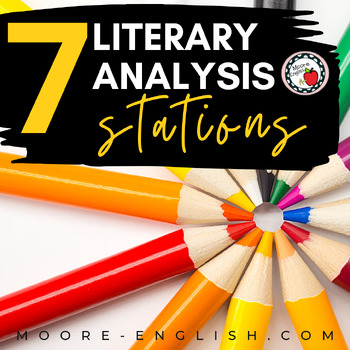7 Literary Analysis Stations for ELA (Plot, Character, Theme, Setting, Author)
- Google Drive™ folder

What educators are saying
Products in this Bundle (7)
showing 1-5 of 7 products
Bonus
Description
Stations are one of my favorite ways to bring movement into the language arts classroom. In the pandemic world, I have used traditional stations less, but as we start to dig our way out of all this, I have started to dust off some of my favorite stations ideas. In this bundle, you have everything you need to set up 7 stations:
- Theme Station
- Summary Station
- Characterization Station
- About the Author Station
- Silent Discussion Station
- Figurative Language Station
- Plot, Conflict, and Setting Station
- Station Signs/Labels and Checklist
These tools are flexible. Teachers can use them with literature circles, book clubs, and/or independent reading.
Here's everything inside:
- 5 Plot, Conflict, and Setting Printables (Printable + Google Slides): To help students focus on plot and conflict, I have put together three different plot diagrams. Plus, I have put together a set of six comic book panels students can use to capture plot and conflict in graphic form. For visualizing setting, I have put together a postcard template so students can capture the mood of the setting.
- 2 Theme Graphic Organizers (Printable + Google Slides): My students spend a lot of time engaged in thematic analysis. Graphic organizers are one of my favorite ways to help students see the connections between author's choices and theme. These two graphic organizers ask students to determine a theme and then identify three pieces of text evidence to support the theme. My favorite way to use these tools is during pre-writing.
- Figurative Language and Literary Devices Single-Player BINGO (Google Slides): This is not your typical BINGO board! Instead of teachers calling out terms to students, students find the terms in their reading scavenger-hunt style. As students find various terms, they work toward creating BINGO. I've included a variety of figurative and literary devices. Some of the more common devices repeat to give students a better chance of "winning." There are five boards total, and they feature a variety of terms: figurative language, irony, plot and conflict, and theme.
- Direct Quotation, Paraphrasing, and Summarizing Graphic Organizers: I have put together a collection of graphic organizers that help students practice using direct quotes, turning the quote into a paraphrase and summary. As a challenge, some of the graphic organizers ask for MLA-style Works Cited entries. As a fun bonus, I have also included a page that asks students to practice summarizing in the form of tweets.
- 4 Silent Discussion Templates (Google Slides): Classroom discussion is a staple for me! In classroom discussion, students can explore a variety of perspectives, practice speaking and listening skills, and work through productive disagreements. With distance learning, I wanted a flexible, asynchronous option. That's where these Silent Discussion templates were born. In this resource, you will find four templates for silent discussion. All you have to do is type in the questions and the expectations/norms for the discussion.
- 7 Characterization Printables (.PDF + Google Slides): During short story and novel studies, focusing on characterization is an important part of helping students analyzing author's purpose, theme, and point of view. The printables in this resource include:
- Character Profile
- Character Cell Phone
- Character Social Media
- 2 STEAL Printables
- 2 Character Dialogues
- Classroom Stations Signs (16 signs): I wanted to refresh my stations signs. Putting the new signs together was so much fun that I wanted to share them with you!All together, this include signs for Stations #1-10, a First Aid Station, a Sanitizing Station, a Sign-In Station, and two blank templates. Everything is included as a .pdf.
- Design an About the Author Page and Stations Checklist: As two bundle bonus files, I have included an About the Author Page and a Stations Checklist. The About the Author Page can be its very own station where students can learn a. little bit more about the author while practicing their research skills. The Stations Checklist is something I started using more recently to help students keep track of the work they have accomplished and to visualize what they have left.
If you were to purchase each of these stations separately, you would spend $11, but with the bundle, you will only spend $8.99, which is like getting one of the resources for free. Plus, you get the bundle exclusive bonus files! All together, that's 52 pages and 7 stations worth of resources!
Since these are Google resources, when you purchase this resource, TPT will create a file in your Google Drive where you will find the .pdfs and Google Slides.
Check out these related resources:
-30 Plot and Conflict Task Cards
-30 Characterization Task Cards
-30 Research and Informational Text Flash Cards
-30 Figurative Language and Literary Devices Flash Cards
Keep in touch and get more great ideas for teaching secondary ELA!
Find more great classroom ideas at Moore English!
-5 Poems for Teaching Story Elements
-6 Poems for Teaching Characterization
-10 Memorable Poems for Teaching Main Idea
-5 Lessons to Make the Most of Teaching Short Stories
-10 Interesting Poems for Helping Students Master Inference
Credit for Comments
Thank you for downloading this product. I’d love your feedback, and for each rating and comment you provide, TpT will give you credit toward a future purchase! Login in to your TpT account, click My Purchases, and beside each purchase, you’ll find a link to Provide Feedback! Rate, comment, and earn TpT credit! Let me know how you use this product in your classroom, what resources I should work on next, and ideas you have for Moore English





